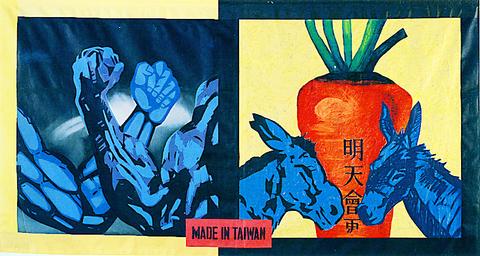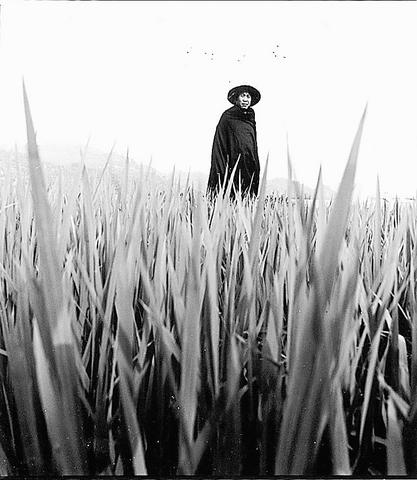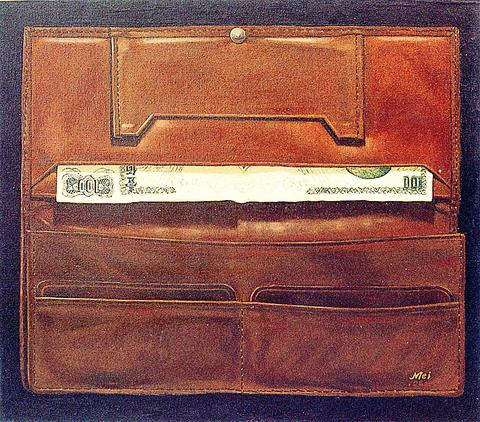Television news corporations going after political figures seldom have to venture into galleries of contemporary art. Last Saturday, however, they gathered at Jeff Hsu's Art to listen to former DPP legislator Shi Ming-teh (施明德) reaffirming his resolution to run for mayor of Kaohsiung and his criticism of the Legislative Yuan. The setting for the coverage was the first group exhibition of contemporary political art in Taiwan.
Hopeful, Critical and Spiteful -- Taiwan Political Art Exhibition (期許、批判與宣洩台灣政治藝術聯展), currently on show at Jeff Hsu's Art (觀想藝術), showcases 44 works by 14 artists dealing with political issues in Taiwan over the past 20 years. Not created to serve any particular political cause, they are creative expressions of the shifting political milieus throughout Taiwan's recent history.
The earliest historical event to figure in the exhibit is the 228 Incident of 1947.

PHOTO COURTESY OF JEFF HSU'S ART
Eagerly anticipating the arrival of the KMT administration from their "motherland" after Japanese rule ended in 1945, the Taiwanese were deeply disappointed by the regime's arrogance and corruption. Triggered by a brutal police crackdown on a woman caught peddling bootleg cigarettes in Taipei, pent-up anger boiled over in 1947 into a full-scale battle between civilians and the KMT government which lasted two weeks.
Chen Shih-chiang's (陳世強) Taiwan History Triptych (台灣風雲三連作) uses comic-book techniques in his collage to blend the history of this bloody clash with present-day police-civilian confrontations. Some apocalyptic depictions of urban Taipei are especially alarming.
In photojournalist Ho Ching-tai's (

PHOTO COURTESY OF JEFF HSU'S ART
In 1990, Ho spent one year interviewing and photographing victims of White Terror. The four portraits selected from the resulting album are shown along with the subjects' stories of their imprisonment and how they look back on it. The stories are fraught with not a little tragic irony. A black piece of cloth appears in various ways in each of the portraits to help tie the photos together and create dramatic tension.
Before the lifting of martial law in 1987, the absolute authority of everything symbolic of the nation and its political leaders could not be questioned, even in works of art. Dean E Mei's (
As a number of political parties burgeoned in the post-martial law 1990s, so did the number of works of art meant to discuss the phenomenon.

PHOTO COURTESY OF JEFF HSU'S ART
The Battle of the Dragon, Tiger, Lion and Leopard (夜炎舞龍、虎、獅、豹鬥) video documents Lee Ming-shen's (李銘盛) 1998 performance. In the video, shot in front of the Taiwan Fine Arts Museum in Taichung, Lee directs four excavators painted blue, green, yellow and white respectively to symbolize different political parties to fight each other. A group of chickens in their midst get fidgety as the fight heats up. The outcome of the fight -- which we'll not reveal here -- shows the ludicrous nature of election battles.
Elections are also the subject of Su Wang-shen's (
While these artists observe and criticize politics on the side, Chang Chen-yu (

PHOTO COURTESY OF JEFF HSU'S ART
Chang Evergreen's Who Did It? (是誰做了它?) is a record of his picketing in front of the CKS Memorial Hall in 1990 in support of the re-election of the then national assembly. One year later, Chang ran for a seat in the national assembly on an artistic platform spelled out in the Election Posters (選舉藝術) series. Under headlines such as "Spiritual President Manifesto," Chang challenges the low priority of art and culture on Taiwanese politician's agenda.
The lifting of martial law after 40 years of censorship prompted many artists to apply their new-found freedom to dealing with political issues in their works. As this freedom risks being taken for granted, it's quite possible that the period this exhibition covers will someday be seen as the "golden age" of political art in Taiwan.

That US assistance was a model for Taiwan’s spectacular development success was early recognized by policymakers and analysts. In a report to the US Congress for the fiscal year 1962, former President John F. Kennedy noted Taiwan’s “rapid economic growth,” was “producing a substantial net gain in living.” Kennedy had a stake in Taiwan’s achievements and the US’ official development assistance (ODA) in general: In September 1961, his entreaty to make the 1960s a “decade of development,” and an accompanying proposal for dedicated legislation to this end, had been formalized by congressional passage of the Foreign Assistance Act. Two

March 31 to April 6 On May 13, 1950, National Taiwan University Hospital otolaryngologist Su You-peng (蘇友鵬) was summoned to the director’s office. He thought someone had complained about him practicing the violin at night, but when he entered the room, he knew something was terribly wrong. He saw several burly men who appeared to be government secret agents, and three other resident doctors: internist Hsu Chiang (許強), dermatologist Hu Pao-chen (胡寶珍) and ophthalmologist Hu Hsin-lin (胡鑫麟). They were handcuffed, herded onto two jeeps and taken to the Secrecy Bureau (保密局) for questioning. Su was still in his doctor’s robes at

Last week the Democratic Progressive Party (DPP) said that the budget cuts voted for by the China-aligned parties in the legislature, are intended to force the DPP to hike electricity rates. The public would then blame it for the rate hike. It’s fairly clear that the first part of that is correct. Slashing the budget of state-run Taiwan Power Co (Taipower, 台電) is a move intended to cause discontent with the DPP when electricity rates go up. Taipower’s debt, NT$422.9 billion (US$12.78 billion), is one of the numerous permanent crises created by the nation’s construction-industrial state and the developmentalist mentality it

Experts say that the devastating earthquake in Myanmar on Friday was likely the strongest to hit the country in decades, with disaster modeling suggesting thousands could be dead. Automatic assessments from the US Geological Survey (USGS) said the shallow 7.7-magnitude quake northwest of the central Myanmar city of Sagaing triggered a red alert for shaking-related fatalities and economic losses. “High casualties and extensive damage are probable and the disaster is likely widespread,” it said, locating the epicentre near the central Myanmar city of Mandalay, home to more than a million people. Myanmar’s ruling junta said on Saturday morning that the number killed had